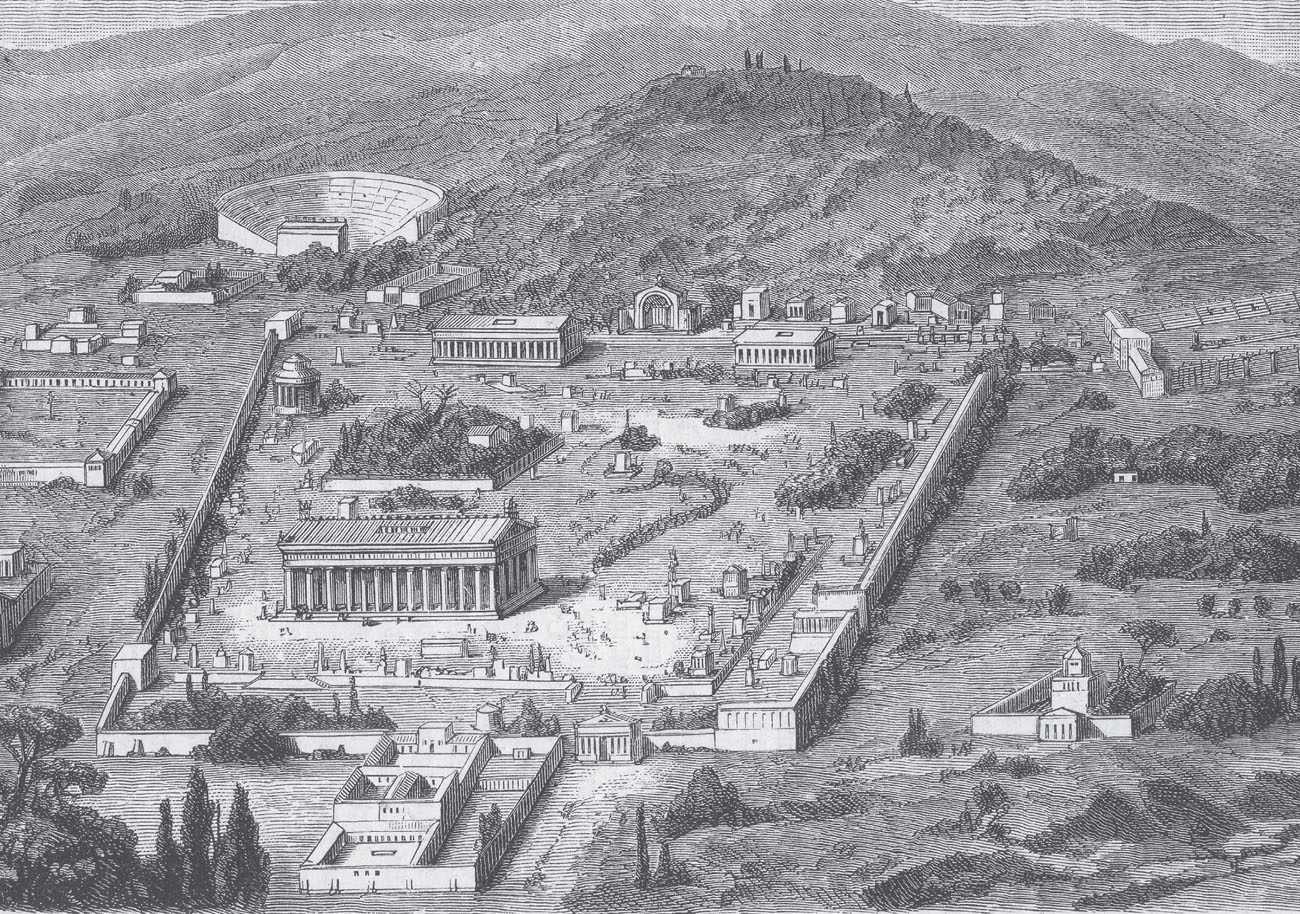Only free men who spoke Greek could compete in chariot racing or other Olympic games.
Footraces and chariot races were just two events of the Olympic Games in ancient Greece. Wrestling, long jump, and boxing were other events. The first recorded Olympics were held in 776 BC. The games took place in Olympia, a town in western Greece. For 1,000 years, the Olympic Games were held every four years.
Today the Olympic Games continue to be held. It is one of many . Ideas from literature and science also have their roots in ancient Greece.
FACT
Before each Olympics, the ancient Greeks stopped all warfare. The break in fighting allowed people to travel to and from the games safely.
No Uniforms
Except for the chariot drivers, ancient Olympic athletes didnt wear clothes. Only men competed in the ancient Olympics. Each man protected his skin with olive oil and fine sand. After the games, athletes scraped off the oil and sand using a tool called a strigil.
Nearly all of the buildings in the ancient Greek city Olympia were for worshipping gods or for the Olympic Games.
CHAPTER 2
THE FIRST SETTLERS
Early Greek settlers learned the best ways to live in the varied landscape of southern Europe. The Greek mainland bordered the northern Mediterranean Sea. Mountains separated villages. People lived in valleys and on open plains. Only small areas near the coasts were good for farming.
The Minoans
The Minoans formed the first Greek settlement on the island of Crete south of the mainland. They lived there from 2200 BC to 1450 BC. The Minoans built a huge and a large fleet of ships. Their ships allowed them to trade with other civilizations.
The Minoans also built palaces. They covered the palace walls with paintings showing peaceful, happy people. The Minoans largest palace honored King Minos. Greeks believed Minos was a son of Zeus. They believed Zeus ruled over all the other gods.
The Mycenaeans
By about 1600 BC, the Mycenaeans had settled on the Greek mainland north of Crete. A king ruled each city. Mycenaeans built huge walls around their palaces. Paintings, gold, and jewels decorated the palaces.
The Minoans built a large palace known as Knossos on Crete. Ruins of the palace still stand.
The Mycenaeans were great warriors. Around 1450 BC, they invaded Crete and conquered the Minoans. According to legend, around 1220 BC the Mycenaeans also conquered Troy. This city was on the northwestern coast of Asia Minor. Today the area includes the country of Turkey.
Few Mycenaeans remained in Crete or the Greek mainland by 1200 BC. Their palaces on the mainland were destroyed. Historians believe they were invaded by another civilization. The Dorians from northern Greece later took over Crete.
The ruins of Troy were discovered in the 1800s. Before the discovery, some people believed the city never existed.
FACT
Scientists believe a volcanic eruption might have caused major damage on Crete around 1600 BC. This damage could have helped the Mycenaeans defeat the Minoans.
Were the Trojans Tricked?
Stories about the Trojan War were passed down through time. One of most famous involves a huge wooden horse. For many years, tall walls around Troy kept the Greeks from invading. To sneak in, the Greeks gave a hollow wooden horse to the Trojans as a gift. The Trojans dragged the horse into the city. They didnt know Greek soldiers were hiding inside. At night, the soldiers climbed out and opened Troys gates. The Greek army then entered the city and defeated the Trojans.
re-creation of the Trojan horse
The Dark Age
Historians know little about Greece from 1100 to 800 BC. During this time, Greece was a land of small farming villages. These villages had little contact with one another. Historians call this period the Dark Age.
Around 800 BC, the Greeks appeared in history again. They built in Europe and Africa. They traded with people in western Asia and learned to make iron tools.
The Phoenicians lived across the Mediterranean Sea to the east. The Greeks traded with the Phoenicians and learned their alphabet and writing system. They also learned about Phoenician art and shipbuilding. These new skills helped end Greeces Dark Age.
Ancient ports along the Mediterranean Sea were busy, crowded places as people received and sent out goods.
FACT
Historians have not found any Greek writings from the Dark Age. They believe the Greeks had no system of reading or writing during this time.
CHAPTER 3
RISE TO POWER
By the end of the Dark Age, the Greeks had built many villages. Most villages were built around a high hilltop called an acropolis. The farms and villages surrounding each acropolis joined to form a city-state. Each city-state ruled itself and had its own army.
By 700 BC, hundreds of independent city-states had formed. The two most powerful were Athens and Sparta.
Athens
Athens was on the east side of Greece near the Aegean Sea. Athens had a port city called Piraeus. This port allowed Athens to launch its powerful navy and trade ships. Long walls joined Athens and Piraeus.
Athenians welcomed new ideas and customs. They believed that a city-state should serve all of its citizens. Their beliefs led them to create a .
In the democracy, each free male citizen in Athens could vote on laws and choose leaders. Women and slaves could not vote. An assembly made governmental decisions.




















